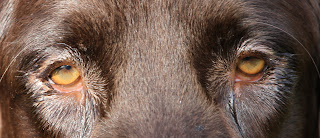Today is the day and Leo is at the vet. Apparently the surgery has gone fine. I'm picking him up at 6pm tonight.
Definition of Entropion
Entropion is the inversion, or the turning inward, of all or part of the edge of an eyelid, such that the outer hair-bearing skin comes into contact with the corneal and conjunctival surfaces of the eye. It causes varying degrees of friction, corneal irritation and potentially more severe damage to affected eyes. Entropion can occur on the upper eyelids, the lower eyelids, or both, although it is more common in the lower lids. This is the most common congenital defect of the eyelids of domestic dogs.
Causes of Entropion
Entropion can be developmental/congenital (called primary entropion) or acquired (called secondary entropion). It is common in dogs and usually is apparent before one year of age - especially if it is congenital. Developmental entropion has a strong genetic component and is frequently caused by a hereditary abnormality in facial conformation and eyelid support. It is much more common in certain breeds whose faces are flat and whose noses are short. Breeds with pronounced heavy facial skin folds are also predisposed to entropion. The actual genetic basis of entropion is not well understood.
While most cases of entropion are developmental due to a hereditary predisposition tied to facial conformation and muscular and ligamentous eyelid support, entropion can also be acquired by dogs of any breed. Acquired entropion can be caused by eyelid spasms (called blepharospasm), loss of tone of the orbicularis oculi muscle, eyelid trauma, chronic inflammation, infection, obesity, marked weight loss or muscle and skin laxity associated with aging. Acquired entropion can be seen at any age but tends to be more common in older dogs.
Prevention of Entropion
Entropion is not “preventable,” per se. It typically is a conformational defect that must be corrected surgically.
Source: PetWave
 The photos here are close up detail. Intended to provide a record of the problem. Photographed on the 1st March 2012 and taken outside in the sunlight hence the dog is squinting a little, rolling his eyes up to avoid the full sunlight.
The photos here are close up detail. Intended to provide a record of the problem. Photographed on the 1st March 2012 and taken outside in the sunlight hence the dog is squinting a little, rolling his eyes up to avoid the full sunlight.We have been putting eye-drops to protect the eyeball and lens twice a day as well as ointment to reduce any inflammation due to the hairs rubbing the eye. The wetness of the eyes in these photos to an extent is a result of the ointment. If untreated though, the eyes do 'cry' onto the lower eyelid due to the rubbing of the hairs on the eye and causing the eye fluids to seep out.
And some more close-ups of the eyes showing the lower eyelids rolling back in.
The vet says this is caused by the eyeballs being slightly too small for the socket and slightly relaxed lower eyelid muscle with too much skin on the lower eyelid.
So surgery involves tightening lower eyelid slightly and the muscle beneath the eye to open it all out.
I'll post a photo post-op to show what has been done. Then I'll put up some photos to show the recovery. It is going to be a tough tow weeks keeping him from rubbing his eyes and the stitches. He'll have a plastic collar and he'll be on the leash in the garden at all times. He'll miss his running.














No comments:
Post a Comment